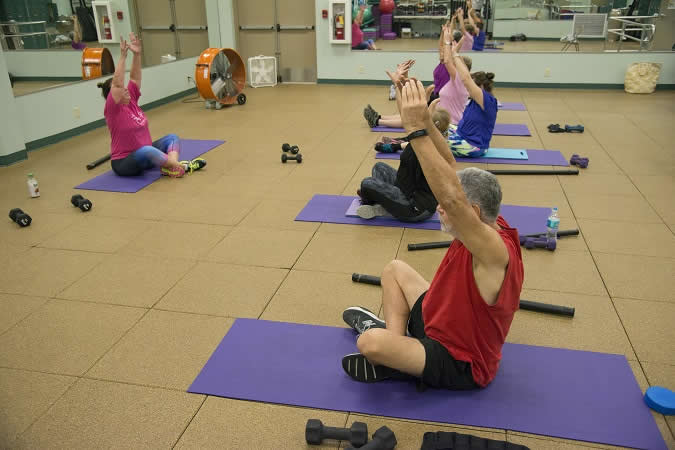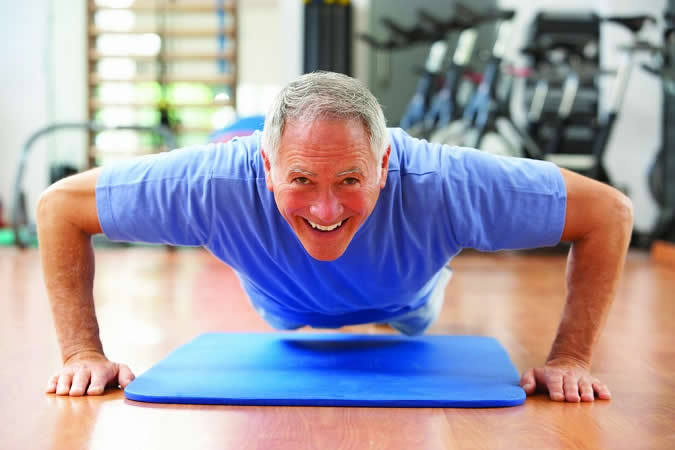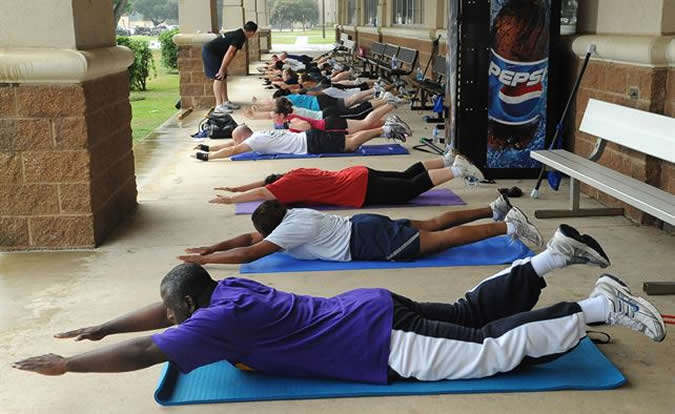Positive Health Online
Your Country

How Yoga Practice Aids Many Age-Related Illnesses in Older Adults
listed in yoga, originally published in issue 243 - January 2018
The statistics around ageing can sound quite grim when you put them altogether. Over 25% of seniors over 65 years of age will develop diabetes according to the American Diabetes Association.[1] 1 in 3 seniors dies with Alzheimer’s or some other form of dementia reports the Alzheimer’s Association.[2] And over half of all adults over 50 experience low bone density or osteoporosis,[3] putting them at risk for sudden fracture and injury. Rates of heart disease are no exception either with over 80% of all cardiovascular deaths occurring in adults over the age of 65.[4]
Many risk factors which contribute to conditions including heart disease and diabetes mirror risk factors for Alzheimer’s. These include having high blood pressure, eating a poor diet, and living relatively inactive lifestyles. While chronic illness is prevalent among seniors, with the AARP reporting 4 out of 5 adults over 50 suffer from one or more chronic conditions,[5] its very management relies heavily on the eating and exercise habits of the adults who develop chronic conditions.

The good news is that mindfulness-cultivating activities like yoga are proving to be accessible and effective solutions to addressing negative lifestyle behaviors which can prove detrimental later in life.
What is Yoga?
The practice of yoga dates back between 5,000 and 10,000 years ago to Northern India. Ancient Vedic religion based on the sacred texts called Vedas is a traditional root of current day Hinduism in India, and millennia ago, was overseen by priests of the Brahman social class. The word ‘yoga’ was first mentioned in the oldest of the sacred Veda texts, and has evolved over the centuries from an amalgamation of ideas, beliefs, and techniques to a practice focused on physical-spiritual connections between the body, mind, and spirit.
Current day yoga practice harkens back to its roots but serves more as an exploration of body-centered postures and movements incorporating deep breathing and meditation. Yoga didn’t make its way into western culture truly until the 19th and 20th centuries, when yoga masters began to travel west, and westerners traveled to Asia and brought back what they discovered about the practice. Hatha yoga is the most popular form of yoga in the west and offers numerous styles for practitioners to take part in - these include:

- Iyengar: Created by BKS Iyengar, this style of yoga focuses primarily on meticulous alignment and employs the use of props, blocks, straps, chairs, bolsters, etc. to help practitioners achieve success with specific postures;
- Ashtanga: This more rigorous form of yoga involves sequenced movements linked to meaningful breathing techniques. More physically demanding than some other styles, Ashtanga yoga involves a specific set of body postures completed in a specific order each and every time without fail;
- Vinyasa: Vinyasa yoga incorporates a continuous flow of yoga postures synchronized with deep breathing that, in its fluidity, is almost dance-like. A very popular form of yoga practice, Vinyasa yoga does not require a certain sequence to poses and offers more free-form movement practice;
- Bikram: With Bikram yoga, you practise 26 different poses in a tailored sequence while also in an artificially heated room. This form of ‘heat yoga’ is meant to help you sweat out toxins and impurities while making your muscles more pliable for the yoga poses;
- Restorative: A yoga style molded for complete and total relaxation and rest, restorative yoga is founded on only a handful of 5 or 6 main poses which are achieved with the use of props, walls, or the ground. Poses are held for several minutes and involve much gentler movement.
Calming the body, mind, and spirit to prepare for meditation through deep breathing and physical postures is the goal of yoga practice. It’s key principles of kindness, non-violence, truthfulness, self-discipline, and peace are meant to help center your energy and bring focus and stress-relief to your body and mind.
While yoga practice might seem like a back-bending, pretzel-twisting hobby for the young and uber-flexible, that couldn’t be further from the truth. For older adults looking for a low-impact and effective exercise that is easy to get started with and which will benefit their health and wellbeing, yoga is a perfect choice.
The varying styles of yoga couple with adaptive modalities help practitioners of all ages tailor yoga practice for specific health conditions and mobility limitations.
Yoga for High Blood Pressure
High blood pressure is almost wholly preventable by taking proactive steps towards a healthier diet and active lifestyle, however, hypertension rates as one of the top most common conditions amongst American adults. The American Heart Association estimates a stark 1 out of 3 adults over 20 years of age actually has hypertension with many not even knowing it.[6]
When the force at which your blood is passing through your circulatory system rises regularly to unhealthy levels it plays undue stress on delicate blood vessels as well as the heart muscle. High blood pressure puts you at risk for developing heart disease, stroke, diabetes, and even Alzheimer’s disease. So how exactly can yoga help?

Yoga practice provides an accessible, low-impact activity for older adults that helps them meet the recommended 30 minutes of moderate-intensity physical exercise a day. The combination of yoga poses can be customized for seniors with mobility problems by using chairs, props, even the water of a pool.
A 2013 systematic review of 17 different studies approaching the question of how yoga practice might affect high blood pressure found that it did indeed have a significant effect in lowering both diastolic and systolic pressures, and could initially be recommended as an intervention in treating hypertension[7]. Experts believe that in addition to the stress-reducing nature of yoga as a mindfulness practice, the physical exertion and focus on stretching and flexibility may address cardiovascular problems, like arterial stiffness, which are believed to also contribute to high blood pressure.
Yoga for Bone Loss
Bone loss almost seems like an inevitable part of aging, especially for women who experience the most drastic loss after menopause. While most adults reach peak bone mass at age 30 and experience minimal loss over the next several decades, in the first ten years following menopause, women lose bone density at rapid rates, putting them at high risk for osteoporosis and unexpected bone fractures. In fact, it’s estimated that roughly 40% of postmenopausal women will experience a fracture as a senior.[8]
In addition to consuming appreciable amounts of vitamin D and calcium which help to strengthen bones, weight-bearing exercises have been shown to help reverse bone loss. Your skeletal bones are actually living tissue, which means they stress and repair themselves regularly, responding to exercise like muscles do by growing stronger.[9] Weight bearing exercises are any physical activity that requires you to work against the force of gravity - these include hiking, walking, dancing, weight lifting, and of course, yoga.
A 10-year study published in 2016 presented quality evidence that a 12-minute daily yoga regimen helped to improve bone mineral density in the femur, spine, and hips.[10] The postures of yoga practice vary by style; however, they are routinely held for a set amount of time and require both weight bearing strength, balance, coordination, and flexibility. Tree pose for example, where you stand on one foot and bring the other foot up to press against your inner thigh, implores your body to work against gravity to hold one leg up while you balance.
Yoga for Alzheimer’s
The older you get, the greater your risk climbs for developing Alzheimer’s. While scientists are still working on a cure, they know that a couple key culprits are to blame for the damage to critical brain cells which results in the memory loss and cognitive dysfunction Alzheimer’s patients develop.[11] Plaques and tangles of protein develop in the brain, starving brain cells of the nutrients and energy they need to successfully communicate with each other and the body. As cells no longer function, they die off, and with Alzheimer’s specifically, this process can be rapid and even result in brain shrinkage.
One powerful tool you can use to defend yourself from this type of cognitive decline is to fortify your brain be amassing a reserve of brain cells through activities like practising fine motor skills, exercising, and learning new things (languages, instruments, etc.) as you age. Hallmarks of Alzheimer’s include not just memory loss, but behavioral changes, issues with critical thinking, problem solving, and decision making, as well as difficulty planning and performing basic tasks. Yoga takes into account both exercise, deep breathing, and meditation techniques which are believed to help Alzheimer’s sufferers (and their caregivers) manage the stress of the disease as well as mitigate some symptoms.
The Journal of Research in Gerontological Nursing illumined in a 2014 study the multiple positive effects chair yoga physically had in older adults with moderate to severe Alzheimer’s.[12] After an 8-week yoga program, participants experienced improved physical functioning, gait speed, and balance. Many common factors which prevent older adults, especially those with chronic illness, from participating in physical fitness including fear of falling, fatigue, weakness, and mobility issues. Yoga’s adaptability to be practised using a chair or other props for bracing yourself make it accessible to a wider audience of seniors, and potentially even motivates older adults to stick with routine exercise.
Final Considerations
The benefits of yoga practice for seniors don’t stop there. Honing flexibility and coordination skills with regular yoga practice can bolster a senior’s confidence and help prevent debilitating falls, similar to using a shower chair for seniors in the bath. Blood pressure reduction, weight management, and cardio exercise achieved through yoga practice also helps to stave off onset of obesity and diabetes as well. And the stress management techniques yoga instills through meditation and deep breathing bears numerous mental health benefits which help to tackle anxiety and depression. If yoga practice has been on your radar but always just out of reach, now is the time to grab hold and embrace it - your own longevity could rely on it!
References
1. American Diabetes Association. Website http://www.diabetes.org/diabetes-basics/statistics/?referrer=https://www.google.com/
2. Alzheimer’s Association. Website http://www.alz.org/facts/
3. Wright NC, Looker AC, Saag KG, et al. The Recent Prevalence of Osteoporosis and Low Bone Mass in the United States Based on Bone Mineral Density at the Femoral Neck or Lumbar Spine. Journal of bone and mineral research : the official journal of the American Society for Bone and Mineral Research. 2014;29(11):2520-2526. doi:10.1002/jbmr.2269.
4. Yazdanyar A, Newman AB. The Burden of Cardiovascular Disease in the Elderly: Morbidity, Mortality, and Costs. Clinics in geriatric medicine. 2009;25(4):563-vii. doi:10.1016/j.cger.2009.07.007.
5. Chronic Care: A Call to Action in Health Reform. AARP Foundation. Website https://assets.aarp.org/rgcenter/health/beyond_50_hcr_conditions.pdf
6. American Heart Association. Website https://www.heart.org/HEARTORG/Conditions/HighBloodPressure/UnderstandSymptomsRisks/Why-High-Blood-Pressure-is-a-Silent-Killer_UCM_002053_Article.jsp
7. Hagins M, States R, Selfe T, Innes K. Effectiveness of Yoga for Hypertension: Systematic Review and Meta-Analysis. Evidence-based Complementary and Alternative Medicine : eCAM. 2013;2013:649836. doi:10.1155/2013/649836.
8. Finkelstein JS, Brockwell SE, Mehta V, et al. Bone Mineral Density Changes during the Menopause Transition in a Multiethnic Cohort of Women. The Journal of Clinical Endocrinology and Metabolism. 2008;93(3):861-868. doi:10.1210/jc.2007-1876.
9. National Institute of Health Osteoporosis and Related Bone Diseases National Resource Center. Website https://www.bones.nih.gov/health-info/bone/bone-health/exercise/exercise-your-bone-health
10. Lu Y-H, Rosner B, Chang G, Fishman LM. Twelve-Minute Daily Yoga Regimen Reverses Osteoporotic Bone Loss. Topics in Geriatric Rehabilitation. 2016;32(2):81-87. doi:10.1097/TGR.0000000000000085.
11. Mayo Clinic. Website http://www.mayoclinic.org/diseases-conditions/alzheimers-disease/symptoms-causes/dxc-20167103
12. McCaffrey R., Park J., Newman D., Hagen D.(2014). The Effect of Chair Yoga in Older Adults with Moderate and Severe Alzheimer’s Disease. Research in Gerontological Nursing. 7(4) 171-177. doi: 10.3928/19404921-20140218-01 [link]
Credit Acknowledgement Citation
Images courtesy of Personal Trainer Pioneer (https://www.ptpioneer.com/)
Comments:
-
No Article Comments available